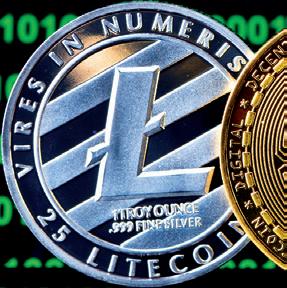
24 minute read
GAME ON!
Elaine Dowman explains why Barclays is banking on the UK’s video game industry
It’s bigger than the film, TV, and music industries combined. Globally, it’s projected to be worth more than $200billion by the end of this year. And right now, more than three billion people worldwide could be doing it. What is it? Gaming.
The creativity of developers in the UK has put the country at the top of the industry’s leader board in Europe, generating £7.1billion in revenue and reaching up to a fifth of the UK’s adult online population. It’s been a GGWP (good game, well played) in gamers’ parlance. No wonder Barclays Bank wants to be a part of it.
“Barclays has been involved in the creative industries since the 80s [but with] a growing focus on the games space in the last four years,” says Elaine Dowman, the bank’s head of games and creative industries, who’s a gamer herself. “After a really long day of work, I often sit down and play… kind of relax and unwind, and escape to a different world,” she says.
Almost 3,000 games-related businesses in the UK are involved in creating that alternative reality. A growing number of them are small, independent developers who often struggle to get the investment they need.
“It makes sense for a bank to support the growth of these UK businesses,” says Dowman. “Developers need to understand finance, because they’ll be pumping a lot of money into a game quite early on. Designing a game could take anywhere between two and seven years. It’s hard to show a prototype, because a lot can change over that time, so it can be a challenge to get funding in the early stages.
“We can help from a banking perspective, but we also have specialist products, like a Video Games Tax Credit Loan, which allows businesses to borrow against HMRC’s Video Games Tax Relief.“
Dowman’s team does a lot to expose those games businesses, she says.
“We’ll run demo days, invite contacts and investors to see what these businesses are doing and allow them to talk about their games. We also work with the UK Interactive and Entertainment (UKIE) trade association. They promote the UK games industry globally, and their line is that the UK is the best place in the world to make games.”
The bank is currently running a six-month mobile gaming scaleup programme with UKIE, tapping into one of the fastest growing segments.
“There are lots of games scaleup programmes out there but very few that focus on the nuances of mobile,” explains Dowman.
In fact, according to Statista, mobile games, with various monetisation strategies and the much larger user base that smartphones provide, will make up a whopping 85 per cent of global video games revenue in 2023.
As a global bank, Barclays works with the industry from corporate to grassroots level and has a well-developed relationship with larger publishers who can support smaller studios. In fact, increasingly, large publishers are working with and acquiring independent studios that will come under their brand, but still operate independently.
“They also need support financially, and may need funding or exposure,” says Dowman.
The Eagle Labs
Possibly the bank’s most important offering for aspiring games companies is its Eagle Labs programme, which recently won the UK government’s Department for Digital, Culture, Media and Sport, Digital Growth Grant to accelerate tech startup and scaleup ecosystems across all the regions and nations of the UK.
Eagle Labs will be responsible for supporting the UK tech sector as a whole from April 2023 to at least March 2025, taking on the role previously held by the not-for-profit Tech Nation, which had helped to bring more than 5,000 startups to the market since 2011, including UK fintechs Monzo and Revolut. It will close its operations this month.
David Hamilton, Barclays ‘ head of implementation, was keen to counter criticism of the government’s decision to choose the startup incubator division of are games-based. That’s good news for smaller developers, who can access the site’s developer suites, kits, and specialist computers.
“In some of the studios, we even have motion capture equipment,” adds Dowman.
As any developer will be painfully aware, hiring this kind of equipment and studio time can be prohibitively expensive. “We can give them the equipment to use, and test things with, before they invest more money into it,“ says Dowman. Games businesses can find support across the entire Eagle Labs network but the specialist equipment and knowledge at those six labs could be invaluable to a startup.
“We’ve tried to locate them around games hubs and make them as accessible as possible. We have labs in Belfast, Glasgow, Sheffield, Liverpool, Southampton, and Brighton, which is a well-known games hub,” says Dowman.
“We hold a lot of events in those spaces, and build a regional community around them for developers, because it can be quite a lonely thing to be. A lot of developers are starting their businesses in their bedrooms, on their own. They know everything about games, but nothing about having an accountant or a lawyer, for example. Eagle Labs can provide those introductions.“
An Industry For The Next Generation
Creating these kinds of connections is particularly useful as crossovers with other industries are becoming more apparent. One in particular – with paytech – highlights the role games can play in seeding innovation, says Dowman.
make quite a lot of money,” says Dowman. “There’s a lot of focus on esports players particularly and their mental health, physical fitness, and their diet. But what about financial literacy? We’ve done a lot of work in the past with Premier League footballers and we’re now transferring that experience to the games space.“
Adapting To Global Crisis
If gaming wasn’t on investors’ radar before the pandemic, they couldn’t fail to miss it afterwards. Who hadn’t heard of Nintendo’s island simulation game Animal Crossing: New Horizons by the end of 2020? Launched in March of that year it sold 13.4 million units in its first six weeks.
Another 2020 success story was PC multiplayer title Fall Guys: Ultimate Knockout, which generated 11 million unit sales in four months.
“They were a form of entertainment that you could play with families at home, but also bring people together internationally, to play games, talk, and share,” says Dowman. “There are incredible stories, about grandmothers and grandfathers learning, so they could play with their children on the other side of the world to still be able to connect with them.” a FTSE 100 bank to receive taxpayer funding, saying Barclays had been ‘getting our hands dirty’, supporting startups and scaleups for the last seven years. “We’re not late to the party,” he said. Indeed, the bank’s Eagle Labs UK network has grown to 38 physical sites since its inception in 2015 covering the whole of the UK. Six of those Eagle Labs
Within the first few months of the pandemic, lockdowns drove a double-digit increase in the time spent on gaming across the world –in Latin America, screen time went up by an astonishing 52 per cent, according to Statista. As a result, worldwide digital gaming spending on in-game content and paid downloads increased by 12 per cent and 21 per cent respectively.
It was relatively easy for the industry to scale to demand.
“A lot of industries look to gaming for innovation, particularly in the micropayments space. You just have to look to the streaming world and esports. And, because it’s a global industry, there’s a need for foreign exchange… I’d say games are leading in that space.“
The growing esports sector is dominated by younger gamers and, as such, there is also potential for the bank to play a role in financial literacy.
“You have young people who are esports players, content creators, YouTubers, or streamers on Twitch, who
“When the pandemic hit, a lot of businesses, traditional businesses, took a while to adapt to hybrid working, whereas the games industry actually did a lot of that already, and could change very, very quickly,” says Dowman.
That drove a frenzy of history-making acquisitions over the next two years. Currently, the biggest all-time sale – of Call of Duty maker Activision to Microsoft’s Xbox for $69billion – is sitting in the regulator’s inbox. For lone developers busily making their digital fantasies a business reality and looking on that megadeal with envy, Barclays’ message is clear: it’s game-on with us.
Ron Delnevo asks if central bank digital currencies are less about fending off competition from cryptos and more about advancing a political – and cashless – agenda
It’s hard to believe that it was only in 2009 that the first cryptocurrency – Bitcoin – emerged from the ether, with Satoshi Nakamoto moved to announce the existence of the Genesis Block.
Handily, the year before, the very same Satoshi Nakamoto had developed a blockchain to serve as the public distributed and decentralised ledger for Bitcoin cryptocurrency transactions.
Very logical. First, invent the rails, then find something to run on them. And run Bitcoin, along with many other cryptos, it certainly did, to the extent that in early January 2023, Forbes magazine reported that the total market capitalisation of the top 10 cryptocurrencies amounted to a very cool £560billion.
Cool that is, until we recall that the market cap of Bitcoin alone was north of £900billion only 15 months earlier.
The extreme volatility of cryptocurrency values has rightly frightened many investors. But central banks have been frightened of crypto for very much longer. Indeed, why would any organisation jealous of its centralised powers welcome crypto passengers on Satoshi’s virtually endless rails, which allow alternative currencies to move around the planet without reference to any physical, political or economic boundary – and therefore beyond the control of any central bank?
This made them very nervous, because they believe that without such control the planet’s fragile financial structures could collapse at any time, as actually happened in 2008, when commercial banks that we believed couldn’t fail went ahead and did.
The truth may be that central banks know that there will be occasional partial collapses but they believe that their centralised control means that failing structures can be repaired. The cost of running repairs can be rather high – the UK government alone spent an initial £137billion supporting the country’s banks in 2008, but the emphasis was on ensuring the economy kept grinding on. And it did. Just.
Decentralised cryptocurrencies do not allow such running repairs to be carried out. For all the ‘stability’ that the stablecoin crypto market segment promotes, their value depends entirely on market sentiment – and there is no safety net, no feasible central intervention, to stabilise the market.
Clearly, central banks do not like cryptocurrencies, but they were aware that their launch was a genie that couldn’t be put back in the bottle. Central bankers decided pretty quickly (for them) that the adage ‘if you can’t beat them, join them’ should apply, which meant creating central bank digital currencies (CBDCs).
A CBDC is a digital token, issued by a central bank, whose value is pegged to the value of that country’s fiat currency. Essentially, CBDCs were initially envisioned as a centralised – and controlled – rival to cryptocurrencies. But the thinking behind them has moved on. Here’s how it stands as of November 2022, articulated by Christine Lagarde, President of the European Central Bank: “We will continue to provide cash, but if it is used less and less for payments, public money could ultimately lose its role as the monetary anchor for the hybrid model, threatening its key function in securing trust in payments, with implications for the economy. Payments are a public good that is simply too important to be left to the market.”
And how does Lagarde envisage countering this threat?
“Issuing a digital euro would indeed safeguard people’s confidence that ‘ one euro is one euro’, allowing them to convert private digital money at par into digital central bank money,” she said.
“It would ensure that money continues to be denominated in euros. And it would be based on a European infrastructure, facilitating intermediaries to scale payments innovation throughout the euro area and thus strengthen Europe’s strategic autonomy.” creating a ‘cashless’ society – however far from that position the country is at present. Sure enough, the India Central Bank launched the pilot of the digital rupee in December 2022. No usage data is yet available, although the Indian authorities must surely be concerned by the poor results so far emerging from Nigeria.
This really isn’t about defending the euro against cryptos, though, because in the same speech, the ECB President remarked that ‘unbacked [crypto] variants – such as Bitcoin or Ether – are too volatile to act as a means of payment’.
So, if there is no genuine threat from cryptos to cash as a payment method for the masses, why would the ECB bother to launch the digital euro?
Simple. The ECB knows that Europe has never been able to create a rival to the big international card schemes. This failure has been underlined recently by the appearance on the payments landscape of the big tech wallets, led by Apple Pay. None of these new raptors of the payments industry is headquartered in Europe.
The ECB sees a digital euro as having the potential to usurp the dominant position of the mainly US-based payment giants. Europe’s Central Bank would be quite happy to see the fiat euro disappear entirely, so long as every Eurozone citizen uses the digital euro for all their payments.
So, the digital euro, initially positioned as an alternative to cryptocurrencies, has now become just another weapon to be deployed in the war against physical cash. Sad – but predictable.
Meantime, in China, piloting of the digital yuan began in 2021. The consensus in the West is that this CBDC is ultimately intended to assist China and its allies to undermine the current position of the US dollar as the planet’s reserve currency. However, it looks like ‘ultimately’ may be a very long way off.
The success of the Chinese launch can probably best be judged from this quote in early January 2023 from a former director of the Peoples Bank of China, Mr Xi Ping: “The results are not ideal of a screen, whether welcomed by the Fed or not. If it isn’t broke, why fix it, is the likely Fed stance, when all things have eventually been considered.
But what of the Bank of England, the UK’s Old Lady of Central Banking?
In April 2021, the bank and HM Treasury initiated the joint CBDC Taskforce to coordinate the exploration of a potential UK CBDC. The bank also set up the Engagement and Technology forums, where relevant stakeholders from industry, civil society and academia could provide strategic and technical input to the work on CBDC.
Speaking at the time, Economic Secretary to the Treasury, John ‘Silicon’ Glen, said: “This consultation will begin an open discussion on the role a UK central bank digital currency might play in the UK.”
As of January 2023, it seems that no decision has yet been taken regarding the launch of a digital pound. However, on 10 January 2023, five UK associations –including UK Finance, which speaks for all major UK banks – announced that they have come together to form a new alliance; namely the UK Forum for Digital Currencies (UK FDC), which will ‘celebrate innovation and collaboration’ in the payments industry.
Can we detect a similar thread of thinking among other central bankers worldwide?
Two central banks rushing into the CBDC era are the Nigerian and Indian. The Nigerian Central Bank launched its CBDC, the eNaira, in October 2021, thus becoming the first significant economy to implement such a product. This launch was no half-hearted matter. All businesses in Nigeria that accept physical cash – the fiat naira – are now also obliged to accept the eNaira for payments.
Despite significant promotion by the NCB, by September 2022 only 270,000 eNaira digital wallets were in use in Nigeria. Considering the population of the country is currently 219 million, this take-up has to be seen as disappointing. However, with the Nigerian government steadfastly anti-cash, the central bank may take the view that every little eNaira helps the move in the direction of the ‘cashless’ dream.
India is another market where the government is seemingly obsessed with
[and] usage has been low, highly inactive.”
So that’s Nigeria, India and China shakily on the CBDC bandwagon – with two of them finding that their citizens have so far shown little or no interest in the digital dreams of their central banks and are happy to continue to use their previously preferred payment methods. In Nigeria and India, for most that means cash.
Apparently, around 80 central banks are currently seriously considering launching their own CBDC. However, the most important of all the central banks – the United States Federal Reserve – is still in information-gathering mode. It is probable that a digital dollar will never appear; the fiat dollar works brilliantly for the US. Dollars are one of the United States’ most successful exports – and, of course, the great thing about fiat currency is that when it is exported, it often doesn’t ever return. Digital dollars would buck this helpful trend. They can return home at the tap
It is highly unlikely that this UK FDC would have been created without a nod from HM Treasury that the digital pound is soon to be let loose on an unsuspecting UK public. A digital pound has a good fit with the anti-cash agenda that has been the goal for a decade or more. HM Treasury may well see this as being the final nail in the coffin of physical currency.
However, in states where citizens continue to enjoy a healthy measure of payment choice, such as Nigeria and India, there is little evidence that the public wants to replace the fiat currency with a digital alternative. In China, of course, though the digital yuan seems to have little public appeal, the government is in the position to impose a ‘cashless’ future on 1.4 billion people. Would a UK government dare to impose a digital pound on its electorate? We shall see.
As the crypto winter deepened, following the collapse of what turned out to be a very unstable stable coin ecosystem built around TerraUSD and Luna, the world’s longest-running exchange launched a new online resource. Its goal was to help investors of all stripes and none get a handle on what was going on more broadly in the alternative currency universe.
The Bitstamp Learn Center aims to explain the mechanics underpinning blockchain technology and crypto assets in an unbiased manner. The need for education is more important now than ever, especially after the 2022 capital-destroying events that led Bitstamp’s Asia Pacific general manager Leonard Hoh to describe the year as a ‘watershed’ for the industry.
By the time the year closed, trillions had been wiped off the value of the total crypto market, and FTX, another leading exchange, had collapsed. US federal investigators later extradited FTX’s co-founder from The Bahamas to answer fraud charges.
In the wake of these seismic events, regulators around the world accelerated efforts to bring crypto providers into line with the long-standing supervision frameworks designed to ensure the fiat-based economy operates with an acceptable degree of probity and integrity.
Thailand and Singapore have already taken action, Hong Kong’s new framework will be introduced this month (March) and Australia says legislation is on track for later this year. Bitstamp’s most recent Crypto Pulse survey (in August 2022 – before FTX hit the skids) revealed that 26 per cent of the 23,000 people it polled worldwide didn’t invest in crypto because there was ‘not enough regulation in the industry’.
Bitstamp, however, was the first crypto services provider to be granted a payment institution licence in the EU and it now holds 51 licences worldwide, including in EU member states, the US and Canada.
Almost a third of its workforce is involved in compliance, regulation, legal, risk management, security, and internal audit functions. But, as with any investment vehicle, it’s also behoven on individuals to conduct their own due diligence and to at least understand the asset and the fundamental mechanisms involved in trading it. The problem is, no one teaches this stuff. That’s what the Bitstamp Learn Center sets out to address.
The Fintech Magazine sat down with three members of the Bitstamp team involved in delivering the resource –content manager Jonathan Metais, head of strategic partnerships Shadman Salem, and head of retail product marketing Aysenur Yükselal Aji. We began by asking how good a grasp some of them had of crypto when they first became involved with it.
JONATHAN METAIS: I purchased a fraction of Bitcoin in 2017, the day that it reached its high – and I rapidly witnessed my investment crash throughout the next few months! When this happens, you either have to cut your losses, or learn more. I chose the latter and haven’t looked back since.
Once you go into that rabbit hole, it’s very hard to get out of. I was a teacher at the time, and secured an internship writing educational content at CoinDesk during the summer. I found that writing about the space was the best way to learn about it.
Eventually, I moved from teaching to working full time in crypto – still teaching, but in a different context.
SHADMAN SALEM: I used to work in asset management at a major Canadian bank and am a CFA Charterholder. From that TradFi Perspective, I always regarded crypto as a risky alternative asset class because I knew very little about it.
In 2017, I was working as a management consultant and my team conducted a research project for a global fintech on the opportunities and threats that crypto-based tech presented to their core business model.
Once I put in the hours, I realised that ‘crypto’ can be a technological (and sometimes philosophical) upgrade to the traditional financial system, incorporating cryptography and a single source of truth to enable transactions without manual intermediation.
The major barriers were certainly in communication – the industry often uses new language and jargon to describe activities, which I had to put in the hours to overcome and bridge my TradFi mental models to crypto.
TFM: So how much do people outside of the industry really understand about the space?
SS: We ran several research surveys with retail and institutional participants in the financial services industry to really understand what acts as a barrier for them to engage with crypto –and what we found was, overwhelmingly, there was a lot of interest in the transformational potential for the tech, but a lack of trust in institutions that act as the gatekeepers.
On the institutional front, those that understand crypto, understand it well and are taking high conviction positions in trading or other blockchain use cases. But, on the retail front, it’s a mixed bag. There are power users who really know what they’re doing and engage with crypto confused. They find the crypto landscape to be like a minefield, with its own language, filled with jargon. And they don’t know where to begin. and DeFi in meaningful ways but that’s still a small percentage of users overall.
Younger generations, like Millennials, have a higher level of passion and optimism towards crypto. Their level of fear is compared to Generation X and Boomers. This enthusiasm motivates them to learn more and educate themselves, but their area of focus differs from the older generations.
They have a good understanding of the new coins and projects, but it’s questionable how deep they go into the detail. On the other hand, older generations prefer to gain a complete understanding of the fundamentals before they invest.
TFM: So who bears responsibility for improving their understanding and communicating the risks and benefits?
When you look at more mainstream users, there’s still a massive gap in understanding and a lack of credible educational resources.
AYSENUR YÜKSELAL AJI: As service providers, we have started to gain a deeper understanding of our customers, both existing and potential. This helps us to bridge the gap between our services and the requirements of retail investors. Education is one of the most crucial needs of these investors.
Based on the latest customer research that we conducted among the individuals who are new to the crypto world or indeed plan to become investors, they feel very
JM: I believe crypto should be taught in schools. But I firmly believe that investing and finance more generally should also be taught in schools, and they’re not, either.
Learning about Bitcoin has helped me acquire general knowledge about economics, technology, investing, and finance. That’s the beauty about crypto. You can learn and teach a wide range of topics through it. And crypto is exciting; it’s new and it’s fun, this would help engage students and help them learn about more than one topic through it.
SS: The industry. It’s our job to simplify the user experience and remove educational and communication barriers for our users. The pandemic saw increased penetration of e-commerce and a need to engage with others in virtual settings, and a lot of those consumer behaviours and habits are sticky and won’t change back.
So, if you think about the things that you need to facilitate a truly seamless and digital experience, the ability to store and transfer value in a trustless and/or digital native way is crucial.
Digital assets are very much front and centre of that type of experience and I absolutely believe that education is key to ensure mainstream users are aware of the risks and benefits as they start to navigate increasingly digital worlds.
AA: As service providers, it’s our responsibility to provide better educational assets to overcome the various challenges in the market. To make crypto more widely accessible, we need to address several layers – including security and regulation.
. Our survey in the financial services industry also showed that nearly half of the retail audience views crypto as less regulated compared to other investment tools, primarily from the non-investor segment. So here, the lack of knowledge becomes apparent.

At the operational level, I can’t envision someone who is not tech-savvy, such as my mother, performing a crypto transaction between different wallets. To make crypto more accessible, we need to make these operations more user-friendly so that people feel confident and secure when making crypto investments.
When we’ve addressed the fear in these layers, I believe crypto will become more accessible. There will always be bad actors trying to take advantage of new users. This is not about crypto; it’s about humans.
Service providers like Bitstamp apply strict security and due diligence processes to protect their users from these bad actors, but when new users have a better education about crypto services and assets, they will be better equipped to choose the right service provider and investment assets for themselves.
Investment has many different layers, but the two most important ones, in my opinion, are firstly how to understand the value of an asset, and then how to choose the right investment model, according to your personality.
The first pillar can be addressed with educational tools like Bitstamp Learn Center, but the second pillar needs more long-term education. People need to learn the fundamentals of investment early in their lives.
TFM: How does the Bitstamp Learn Center help address the ignorance and fear around crypto, then?
JM: The Learn Center is an online educational hub that anyone can access and learn about blockchain technology, cryptocurrencies, and general finance and investing.
We are keen on providing thoughtful, well-researched, and unbiased content, to reach anyone, regardless of their crypto knowledge, and help engender trust in the space.
There’s a lot of misinformation out there; it’s very easy to read false claims and fall victim to scams. We try our very best to research thoroughly and make it easy for the average user to understand each topic. about technical details of a specific coin, how to buy and sell crypto, or different kinds of trading techniques.
Our articles hover around 1,000 words – a five to 10-minute read – on crypto and blockchain technology. We are also developing other topics, such as Web3, people profiles and security best practices.
We’re a cryptocurrency exchange, too, though, so it’s essential for us to educate our users on trading and investing. We have articles reaching a wide variety of topics, from dollar cost averaging, to the different trading patterns present in candlestick charts.
It's important for us to give a holistic and global view on safe investment practices as well as safe practices within the crypto space. While we don’t want to spook users, we do want to make sure that people safeguard their assets and are well protected.

The most important and most beautiful part of the Bitstamp Learn Center is that it is jargon-free, and people can easily understand when they are reading. We certainly don’t use complex and complicated terminology there.
It’s an educational tool, and we want our readers to feel comfortable while they are learning about crypto.
TFM: You’re obviously doing your best to make ordinary users feel more comfortable and confident using crypto. But do you think it will ever rout fiat and go mainstream? And, if so, what will be the tipping point?

JM: We’re closer than you think. The technology is here; we just don’t have the right platforms right now – at least, we don’t have platforms that are completely intuitive to new entrants. That comes with time. The internet that you know today was not built in a day, so you have to be patient with crypto.
Most of our content is catered to those with no to medium experience. We’re trying to provide a bias-free zone for anyone wishing to either start their crypto journey, or further their learning. Our goal is to eventually build out content to reach the more experienced users .
Being an educator myself, its very important to me that education should be readily accessible to all types of learners. Our goal is to eventually create different types of content, so that anyone can consume articles, via reading, watching, or listening to them.
AA: Bitstamp Learn Center is an education hub for no-nonsense articles, videos, and how-to guides to all things crypto. People can learn more
But, you know, Bitcoin is already being used around the world, from big initiatives like worldwide remittances, to smaller ones, like purchasing pints at a local pub. So,while there is a lot happening behind the scenes, I’d say it will be another five or six years before we see increased mainstream adoption.
SS: That’s a tough one to answer, because there are so many ways to think about what that future model looks like and so many different stakeholder groups that are working towards optimising for their objectives.
But for digital assets to play a truly meaningful role as an alternative currency to fiat we’ll need to see more institutional involvement – from retail and commercial banks, to regulators to central banks.
We are definitely headed in that direction – with more than 100 central banks working on CBDCs (central bank digital currencies) and many private institutions working on transactional use cases for stablecoins. So I don’t think it’ll be long before blockchain-enabled digital currencies are in mainstream use – but ‘crypto’ will very likely look different to what it has in the past.

A reality check, strengthening resolve, and a tipping point for technology. Friends of fintech share their thoughts
CRYPTO & BLOCKCHAIN
Ram Gopal, Director of the Gillmore Centre for Financial Technology, Professor of Information Systems & Management, Warwick Business School
KEY TAKEAWAY: Bitcoin will be seen as mainstream by investors and regulators This year promises to be a significant one for the cryptocurrency market, particularly for Bitcoin. As the market matures, the price of Bitcoin is expected to stabilise, offering a valuable store of value, particularly in the face of inflation.
Bitcoin’s decreased volatility will likely attract more institutional investors, as well as those seeking a secure means of transaction and protection against hyper-inflation in unstable economies.
The increased interest and adoption will also necessitate the development of coherent legislation and regulations surrounding Bitcoin’s use, including tax policies and rules for purchasing goods.
Business Environment
Leda Glyptis, 10x Banking, author and finfluencer
KEY TAKEAWAY: Stormy start gives way to new focus
Historically, I have not been good at crystal ball gazing. All my predictions are off... usually by a few years (ever the optimist). But, sadly, this year is different.
In the midst of a cost-of-living crisis of Dickensian proportions in the UK, as well as an energy crisis, and with a looming recession so far avoided on a technicality, it is easy to be accurate when looking ahead to the next few months. I fear the rest of H1 will be marred by the pattern we’ve seen of redundancies, caution and no more easy money for early-stage startups and 'corporate optionality' projects. Grim. And hard for all affected, so be kind to one another.
There are better times ahead, though. H2 will come with an uplift – not a return to fat early rounds and aggressive growth, but a fresh sense of urgency across the industry to focus on building meaningful products that solve real problems and getting them to customers.
Techno Trends
Brett King, author and futurist
KEY TAKEAWAY:
A year for big tech advances and philosophical debates n GPT 4 will start to see debate about the Turing Test, and whether AI is getting convincing enough to mimic a human. n Commercial gene therapy will be broadly in use for the first time. n We will start to see more major fintech brands talking about IPO. n SpaceX will get its Starship into orbit, leading to renewed debate about the future of humans on Mars.
Cyber Risk
Tom Eggleston, International Claims Leader, UK & Europe at cyber insurer Resilience
KEY TAKEAWAY: Fewer firms will pay ransoms; security spend increases While ransomware remains a significant threat and is by no means going away, fewer companies will pay ransoms. This is a result of increased emphasis on prevention, with companies investing in securing their borders and implementing strong cyber hygiene regimes.
From a regulatory perspective, insurers and financial service companies operating in the UK should pay close attention to statements coming from the Information Commissioner’s Office which has indicated a move of approach towards preventing and remedying harms, versus using purely punitive fines.
However, the new initiative includes publishing on its website all reprimands issued to companies since January 2022.
It is likely these will be monitored by claimant law firms seeking to initiate group actions. So, there is increased threat of reputation harm and third-party litigation risk.
View From Ukraine
Igor Tomych, Founder of Ukrainian software development company
DashDevs and the Fintech Garden community in the UK
KEY TAKEAWAY: There will be more investment when there is more certainty By the end of this month (March) I think we will have a better idea of whether the war is going to be longer or shorter. But the strategic business approach has been to plan less and be more cautious because there’s no visibility. Overall, the software engineering workforce is less than required last year because of that uncertainty. So, at DashDevs, we have remapped where we look at projects.
Banks in Ukraine are cutting down the cost and development of future features. But the banking system is in good shape. Any company that was not sound as a business model [before the war] will fail; a new era will start when things are more predictable.





















